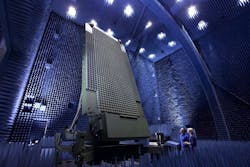Air Force asks Lockheed Martin for 3DELRR expeditionary radar systems for forward edge of the battlefield
HANSCOM AIR FORCE BASE, Mass. – U.S. Air Force tactical radar experts needed an air-defense radar system intended to detect, identify and track enemy missiles as well as manned and unmanned aircraft. They found their solution from the Lockheed Martin Corp. Rotary and Mission Systems segment in Liverpool, N.Y.
Officials of the Air Force Life Cycle Management Center at Hanscom Air Force Base, Mass., announced a $75 million order to Lockheed Martin on Tuesday for the Three-Dimensional Expeditionary Long-Range Radar (3DELRR) system.
Lockheed Martin will build and deliver the initial two 3DELRR radars, as well as production management and supporting tasks. The 3DELRR radar is to replace the Air Force's Northrop Grumman AN/TPS-75 transportable 3-D passive electronically scanned array air search radar for enabling U.S. and allied invasion forces to protect themselves from airborne threats after establishing beachheads.
3DELRR is to be the principal Air Force long-range, ground-based sensor for detecting, identifying, tracking, and reporting aerial targets for the Joint Force Air Component Commander through the Theater Air Control System, Air Force officials say.
Related: Air Force ready to recompete 3DELRR air-defense radar
The 3DELRR system is designed to deal with regional and near-peer conflicts of the future that could involve large numbers of enemy advanced unmanned aerial vehicles (UAVs), fixed-wing aircraft, helicopters, and ballistic and cruise missiles, Raytheon officials say.
3DELRR is designed to detect, identify, and track a wide variety of objects accurately at great distances. C-band is a relatively uncongested portion of the electromagnetic spectrum. The radar is interoperable with coalition systems and meet the requirements of many foreign militaries.
The 3DELRR system is similar to the Ground/Air Task-Oriented Radar (G/ATOR) that Northrop Grumman is building the for U.S. Marine Corps. G/ATOR is being developed to protect Marine Corps expeditionary forces from rockets, artillery, mortars, cruise missiles, UAVs, and other low observables. It is a deployable short-to-medium-range multi-role radar system. 3DELRR, on the other hand, is designed to detect and track threats at longer ranges.
Related: Northrop Grumman to build eight G/ATOR air-defense radars
Like 3DELRR, the G/ATOR is based on GaN technology, yet the G/ATOR system is designed to handle air surveillance, weapon cueing, counter-fire target acquisition, and air traffic control for Marine Corps warfighters operating in invasion beaches.
The 3DELRR will provide the Air Force control and reporting center with real-time data to display air activity, and will provide warning and target information.
The system also will provide operators with a precise, real-time air picture to provide air traffic control services to individual aircraft across a wide range of environmental and operational conditions.
Raytheon Technologies Corp. initially won the 3DELRR contract in 2014, but industry protests held up its initial development. Even before its initial award to Raytheon, the 3DELRR program was in hot contention among three of the nation's most prominent radar houses: Raytheon, Northrop Grumman, and Lockheed Martin.
Air Force leaders opted to recompete the 3DELRR radar program in 2020 because of technical and supplier challenges. Raytheon and Northrop Grumman still may share in some 3DELRR development.
On this contract modification Lockheed Martin will do the work in Liverpool, N.Y., and should be finished by January 2024. For more information contact Lockheed Martin Rotary and Mission Systems online at www.lockheedmartin.com, or the Air Force Life Cycle Management Center at www.aflcmc.af.mil.

John Keller | Editor-in-Chief
John Keller is the Editor-in-Chief, Military & Aerospace Electronics Magazine--provides extensive coverage and analysis of enabling electronics and optoelectronic technologies in military, space and commercial aviation applications. John has been a member of the Military & Aerospace Electronics staff since 1989 and chief editor since 1995.

